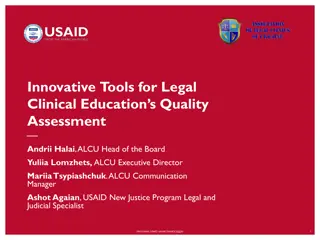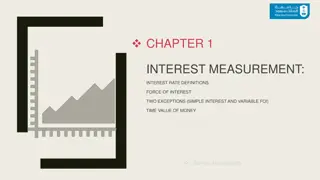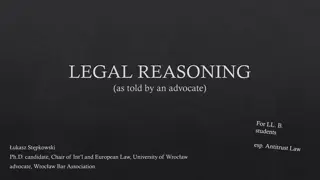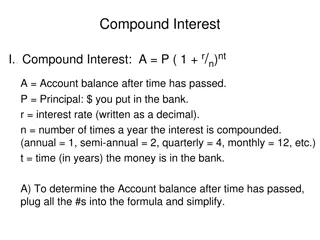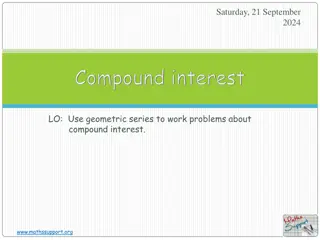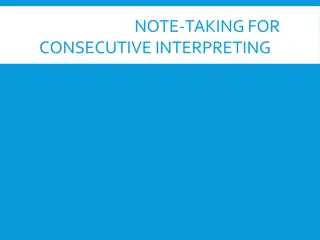Understanding Interest-Taking in Different Legal Systems
This text delves into the historical perspectives and legal frameworks surrounding interest-taking on money loans from the viewpoints of Aristotle, Islamic law, Jewish law, and additional rabbinical stringencies. It explores the origins of usury, prohibitions on interest in different religious traditions, and the evolution of lending practices within various communities.
Download Presentation

Please find below an Image/Link to download the presentation.
The content on the website is provided AS IS for your information and personal use only. It may not be sold, licensed, or shared on other websites without obtaining consent from the author. Download presentation by click this link. If you encounter any issues during the download, it is possible that the publisher has removed the file from their server.
E N D
Presentation Transcript
Prof. P.V. Viswanath Finance and Society
Interest-taking on money loans Aristotle accepted the medium of exchange function of money, but not the store of value function. Usury is most reasonably hated because its gain comes from money itself and not from that for the sake of which money was invented. For money was brought into existence for the purpose of exchange, but interest increases the amount of money itself and this is the actual origin of the Greek word: offspring resembles parent, and interest is money born of money; consequently this form of the getting of wealth is of all forms, the most contrary to nature. Hawkes, D.. The Culture of Usury in Renaissance England, Palgrave Macmillan US, 2010.
Islamic and Jewish law We saw that Islamic law required the linking of a loan to a real transaction. There could not be any unnatural transaction simply in money. Money could not be treated as a commodity. In Jewish law, on the other hand, the moral objection is to what is called neshekh, i.e. biting or extraction of value from a person who is in difficult circumstances, i.e. poor. Legally, however, all interest is forbidden, where interest is defined as compensation for delayed repayment. But since the primary objection is to exploitation, various devices were created to allow the lender to obtain a return on business loans.
Jewish law of Ribbit If you lend money to any of My people, even to the poor with you, you shall not be to him as a creditor; neither shall you lay upon him interest. (Exodus 22:24) Take no interest of him or increase; but fear your G-d; that your brother may live with you. You shall not give him your money upon interest, nor give him your victuals for increase. (Leviticus 25:36 37) You shall not lend upon interest to your brother: interest of money, interest of victuals, interest of any thing that is lent upon interest. Unto a foreigner you may lend upon interest, but unto your brother you shall not lend upon interest, that the Lord your G-d may bless you in all that you put your hand unto, in the land that you go in to possess it. (Deuteronomy 23:20 21) The general principle of ribbit is that all payment for waiting is prohibited.
Whom does the restriction apply to? Only interest taken from or paid to a Jew is prohibited, since interest-taking is not seen as unnatural in itself, but the requirement to help one s brother. This is similar to the commandment to give charity to one s brother. One may give charity to strangers, but it is not commanded. Nevertheless, in the beginning, the rabbis prohibited taking interest from non-Jews, as well, except for the purpose of earning a livelihood. However, over time, as Jews were debarred from many occupations, and usury was one of the few professions open to Jews in Christian and Islamic countries, the rabbis allowed taking interest from non-Jews.
Additional Rabbinical Stringencies The rabbis added additional stringencies to the basic rule prohibiting compensation for deferred repayment. One of these prohibited the use of a gentile to serve as an agent. No Gentile Agency: A Jew may not serve as an agent for a Gentile nor can a Gentile serve as an agent for a Jew. Any action performed by such agents is viewed as being performed on their own initiative, i.e. they, the agents, are viewed as the principals. In the absence of such a rule, there would be the possibility of a simple ploy in allowing intra-Jewish usury. A Jew could appoint a Gentile as his agent to get a loan at interest from another Jew. This would violate the intent of the law against ribbit. Hence the Talmud (Bava Metsia 71b) forbade such an arrangement as a stringency (le-humra) to the law or ribbit. However, the rule of No Gentile Agency could not be used as a leniency to permit transactions where the actual loan was from one Jew to another Jew. This was included in the principle of le- humra.
Relevant Principles of Jewish Law Although Jews were allowed to lend on interest to non-Jews there were many situations where more than one Jew was involved and the transaction between the two Jews resembled a loan. This created difficulties which the rabbis struggled to deal with in order to allow Jews to earn a living. We describe some of these situations below. First, we need to understand a general principle of Jewish law called ribbit mi- loveh le-malveh (interest from borrower to lender). Under this principle, only interest paid by the borrower to the lender is prohibited. If the interest is paid to or by a third party, it is not considered ribbit.
The Pawned Pawn We consider first a case of a gentile G borrowing from a Jew, J1. G borrows from J1 at interest for 2 months and gives him a pawn. Prior to the loan coming due, J1 needs money. He goes to J2, gives him the pawn and borrows at interest. After 2 months, G repays J1, who then repays J2. This would seem to be forbidden, since J2 seems to be lending to J1. Could this be justified in halakha (Jewish law)?
The Pawned Pawn Until Rashi (d. 1105), such a transaction was considered illegal. However, Rashi wanted to permit it since the interest ultimately came from a Gentile; hence the condition of ribbit mi-loveh le- malveh did not apply and the transaction should be allowed. However, the rule of no gentile agency would normally disallow such an interpretation. Hence Rashi interpreted the transaction between J1 and J2 as an acquisition by J2 of G s loan by means of the acceptance of the pawn. Hence in this case, J2 would be lending to G even though J1 would be paying the interest and principal to J2. The problem was that in Jewish law, a lender did not acquire rights in a pawn. Hence J1, not having any rights in the pawn, could not transfer the loan to J2 through a transfer of the pawn. Although debts could be transferred in halakha, the process was complex and transfer of a pawn did not effect a debt transfer.
The Pawned Pawn In German law, however, when A borrowed money from B using a pawn, A had no obligation to repay the loan. If he did, then B would return the pawn and if he didn t, B would keep the pawn. So a loan transaction was actually a real transaction rather than a financial one. In halakha, however, the transaction was a financial one and created an obligation for A to repay the loan. The pawn was simply a way of providing security for the loan. Rashi, in this case, used the ubiquity of pawn transfers to infer an actual sale of the loan concomitant with the transfer of the pawn, effectively applying German law, rather than halakha, and thus permitting the payment of interest. In this way, the halakha was changed through a recognition of facts on the ground and the realization that most commerce at this time was between Jew and Gentile and not between Jew and Jew as in Talmudic times (when the original law was crafted). We now look at how the rabbis dealt with a second case, where a Jew, J1, borrowed from a gentile, G. This is called a case of schadennehmen, a German word which means taking a pawn.
J1 borrows from G at interest for 1 month. After 1 month, G comes to collect, but J1 doesn t have liquid cash. He gives G a pledge and asks him to take it to J2. J2 lends to G an amount equal to principal plus 1 month s interest, using the pledge as security. After another month, J1 gives G the principal plus 2 months interest, which G gives to J2, who returns the pledge. G returns the pledge to J1. Isn t this J2 lending to J1 on interest, since the doctrine of le- humra prevents us from invoking the rule of no Gentile agency and treating the second loan as proceeding from J2 to G? Schadennehmen
Schadennehmen Rashi permitted this transaction as long as J2 did not know that the money to pay the interest was coming from J1. But was not this ingenuous? The original rule of le-humra would seem to apply whether or not the lender had knowledge that the money was coming from a Jew. How could Rashi modify the law in this convenient fashion? The answer has to do with how the le-humra stringency is to be viewed. It could be viewed as a rule which prevented the spirit of the law from being violated. This approach would view ribbit as being a moral rule and hence requiring safeguarding of the spirit of the rule through the application of the le-humra stringency.
Schadennehmen Alternatively, the prohibition on paying interest, ribbit, could be seen as being a hok, a Divine law, whose purpose was not known. If so, the le-humra rule would need to be applied only where the underlying transaction actually violated the prohibition on ribbit. In this case, the le-humra rule would come into play as a punishment for the lender to prevent him from evading the law through a technicality. Rashi took the second view probably because nobody was being hurt in the payment of interest in a business transaction. Hence he would still prohibit the payment of interest in a loan transaction between two Jews. However, he saw no reason to interpret the le-humra restriction broadly and thereby prohibit a loan transaction between a Gentile and a Jew. Since there was no moral issue involved, he felt comfortable in ruling leniently and permitting the schadennehmen transaction.
Reverse Agency Rabbenu Gershom (d. 1028) considered the case of a Gentile asking a Jew (J1) to be an intermediary in obtaining a loan from a second Jew (J2). The principle of no-Gentile agency would treat this as a loan from J2 to J1 and hence no interest could be charged. But in fact, the loan was from J2 to G. How could this reality be reconciled with the halakha? R. Gershom permitted this by viewing it as a case of J2 asking J1 to be an intermediary in facilitating the loan of his money to G. Since this agency is between two Jews and recognized, the loan was, according to halakha, in this view, from J1 to G. What we see in the previous cases is that the rabbis found ways to reconcile the business needs of the people with the religious injunctions. We now look at a general theory of how religious laws might be seen to change over time.
Religious law changes: a general theory How do religious restrictions change over time? For example, what happens when economic circumstances make the restrictions too difficult for people to bear? One answer is for the religious authorities to relax them, by arguing that the original restrictions were overly restrictive. The problem, though, is that if religious authorities are willing to change the rules, that suggests that the original rules were not divinely given at all, i.e. that they were man- made and that is why they can be modified at will. Changes in religious law could lead to a crisis of faith and could lead to an erosion in the power of the religious authorities. On the other hand, if the rules are too difficult, people might stop following them for that reason. How is this dilemma resolved?
Changes in religious laws One answer is that religious authorities come up with a reinterpretation that is consistent with the original scriptural text. A minor reinterpretation that leads to a law that is not too different from the previous law is easier for the populace to accept without a crisis of faith. The bigger the jump, the greater the crisis of faith and the greater the erosion in the power of the religious authorities. However, given a change in circumstances, the smaller the adjustment in religious law to accommodate the new economic circumstances of the populace, the greater the likelihood that the populace will ignore the law, which will then lead to a different kind of problem for the religious authorities. The extent to which people will adhere to the rulings of the religious authorities depends on the institutional setting, which can vary from place to place. In some societies, there may be a greater dependence of the people on the religious authorities, while in others there may be a lesser dependence.
Changes in religious laws Jared Rubin models this problem in the Islamic context by positing a political authority that acts as a representative of the people. The easier the economic circumstances for the people, the easier it is for this government to stay in power, as well. Hence the behavior of the government will be congruent with the needs of the people. We can then think of the dependence of the people on the religious authorities as equivalent to the dependence of the government for its legitimacy on the religious authorities (known as the ulema, in Islamic countries). The degree to which changes in religious law will cause a crisis of faith for the populace can also be conceptualized as the extent to which the ulema are resistant to change. Jared Rubin assumes that the dependence of the government on the ulema changes dynamically over time as the ulema change religious laws in response to changed circumstances. Specifically, the more the ulema change religious laws, the less dependent will the government become on the ulema.
Changes in religious law We now have two players in this game government and the ulema. The ulema is motivated by two things: one, its desire not to see too much of a change in the religious law, which is modulated by its innate resistance to change (which, in turn, is related to the desire to maintain the people s faith); and two, its desire not to lose credibility with the government by being too out-of-step with what is optimal for the government/people. The government is motivated by two things: one, its desire to not make secular law too different from religious rulings, which is modulated by its dependence on the ulema; and two, its desire to not have policies that are too different from what is good for the people. The government s dependence on the ulema at any point in time is governed by a) how far the ulema has moved from its initial position (i.e. the true law ) and b) how far the government and the ulema s positions are from each other. Given these assumptions, the ulema determine the religious law and the government chooses the secular law.
Changes in religious laws In Rubin s model, the dynamic outcome manifests itself as the outcome of a game between the government and the ulema. For convenience, let s consider a specific commercial issue, viz. how difficult it is to engage in debt-like transactions with interest payments. At the beginning, in the Islamic world, the ulema s opening position mght be a very strict religious law, such as the prohibition of interest payments under any circumstances; the government might start out with a particular policy which maximizes the people s unrestricted utility (i.e. without considering what the religious law is). This might be no restriction on interest payments. The government and the ulema then react to each other taking into account their respective motivations and restrictions. The interaction between the ulema and the government might lead to an equilibrium where the ulema allow debt-like contracts with interest payments as long as the lender bears a substantial amount of the risk of the business venture. The government in the Islamic world depended highly on the ulema for legitimation, thus leading the government to enact relatively strict loan regulations congruent with the ulema s position.
Change in religious law in Islam In the late-10thto 13thcenturies, there was a growth of trade making the availability of credit much more important. This meant that the existing equilibrium of religious and secular law was disturbed; the government was now uncomfortable with a strict law. This led the ulema to agree to a change in religious law. However, this flexibility reduced the dependence of the government on the ulema, although it was still rather high, given the high initial dependence of the government on the ulema. Hence even though the post commercial revolution equilibrium involved a more relaxed attitude to usury in the Islamic world, the changes in sharia, the religious law and the changes in the secular law were modest. If we look at the Islamic world today, there is still a prohibition on taking interest of any kind. Debt-like transactions do take place. However, the ulema require that financial transactions be tied to real transactions; this allows the ulema to treat the loan as a sale-and-buyback or a rental agreement, with the interest being absorbed into the mark-up or the rental payment. Straightforward consumption loans are not possible in Islam, and futures contracts and discounted sales of loans are still difficult.
Change in Christian law In the west, on the other hand, usury laws were very strict until the 12thand the 13thcenturies. The church, basing itself on laws in the Bible, was very resistant to change. However, the political authorities were not very dependent on the Church for legitimation, possibly because of the fragmented nature of power in the West, with power being shared by the king, the nobles and the Church. Hence when the commercial revolution arrived, the Church felt obliged to relax its strictures more. This, in turn, loosened the reliance of the secular governments on the Church s legitimation. By the end of the 15thcentury, the Church allowed triple contracts (discussed below) and discounting of bills of exchange. The ultimate outcome, which we see today is one where the Church permits the taking of interest. There is a moral stance against taking excessive interest, but this is only paid lip service in Western countries, if at all. We see that interest rates on credit cards and bank overdrafts are high, and effective interest rates are even higher.
The triple contract and Usury The triple contract involved two parties signing three contracts. The first contract was a partnership contract. E.g., an investor may provide money to a merchant for some prospectively profitable venture. The second contract was a contract for insurance. The merchant agrees to insure the investor against loss of the principal; in exchange for this guarantee on the principal, the investor agrees to accept a lower percentage of the profit than would otherwise come her way. For example, if the venture in question usually results in a 14% return, then the chance at that return is sold for a guarantee on the principal and, say, a return capped at 8%. Of course, if the venture goes poorly, there may be no return at all. A third contract was then signed, where the same investor sold this uncertain future gain for a guaranteed but lower rate. The investor is now insured not only against loss of principal but also against the possibility of obtaining no return. In our example, the potential for an 8% return is sold for a guaranteed return, say, of 5%. Each leg seems to not violate usury laws, but using the complete triple contract, investors could realize a guaranteed return on investment.
Sources AAOIFI statement on Sukuk and its implications, Norton Rose Fulbright, https://www.lexology.com/library/detail.aspx?g=2407133b-7b12- 4e7f-8061-18b19be7de98 The Sukuk Handbook: A Guide to Structuring Sukuk, 2ndedition, Latham and Watkins. https://www.treasurers.org/hub/treasurer-magazine/what-are- sukuk-and-how-do-they-work Rubin, Jared. Institutions, The Rise of Commerce and the Persistence of Laws: Interest Restrictions in Islam and Christianity, The Economic Journal , DECEMBER 2011, Vol. 121, No. 557, pp. 1310- 1339. Abbas Mirakhorand Iqbal Zaidi, Profit-and-loss sharing contracts in Islamic finance, Chapter 4 of Hassan, Kabirand Mervyn Lewis Handbook of Islamic Banking. Guarini, Marcello, "The Triple Contract: A Case Study of a Source Blending Analogical Argument" (2007). OSSA Conf. Archive. 59. https://scholar.uwindsor.ca/ossaarchive/OSSA7/papersandcommen taries/59 https://en.wikipedia.org/wiki/Usury#Church_councils












